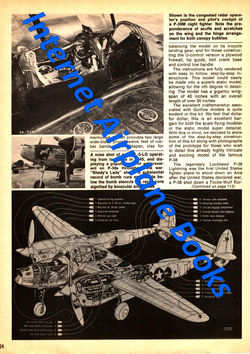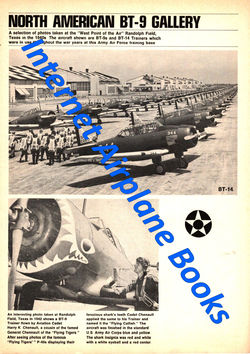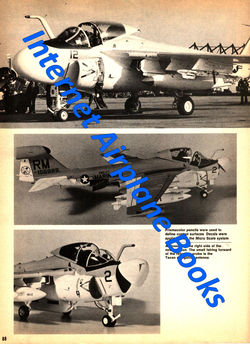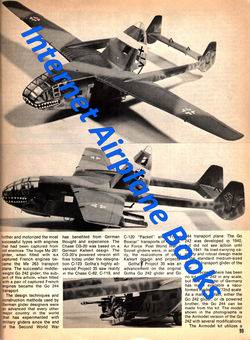SCALE
AIRCRAFT MODELER COLLECTOR’S ISSUE BT-9_USMC EA-6A VCMJ_Go242_F-84E_Be-12_He111
NORTH AMERICAN AVIATION BT-9
TRAINER USAAC USAAF
SUPERMARINE WALRUS FLYING BOAT
POST-WAR CAREER SPOTTING WHALES IN THE ANTARCTIC
WW2 GERMAN LUFTWAFFE HEINKEL
He111 BOMBER KAMPFGESCHWADER KG INTERIOR DETAIL PHOTOS
LOCKHEED P-38 LIGHTNING WW2
USAAF FG FIGHTER TWIN ENGINE
BERIEV Be-12 “MAIL” FLYING BOAT
VIETNAM WAR USAF REPUBLIC
AVIATION F-105 THUNDERCHIEF THUD FIGHTER BOMBER
WW2 9TH AF CURTISS
P-40 WARHAWK NORTH AFRICA WESTERN DESERT
WW1 GERMAN ALBATROS W-4
FLOATPLANE
VIETNAM WAR USAF ACE COLONEL ROBIN
OLDS McD F-4C PHANTOM II 555TH TFW WOLFPACK
WW2 BELL XP-77 BANTAM FIGHTER
WW2 BREWSTER F2A BUFFALO FIGHTER
PLANE USN VF USMC VMF RAF RANGOON BURMA
USMC GRUMMAN EA-6A INTRUDER EW
VCMJ
USAF STRATEGIC AIR COMMAND SAC
BOEING B-47 STRATOJET STRATEGIC BOMBER
WW2 GERMAN GOTHA Go242 ASSAULT
GLIDER
REPUBLIC F-84E THUNDERJET USAF
FIGHTER-BOMBER
-----------------------------------------------------------------------------------------------------------------
Additional Information from
Internet Encyclopedia
The Lockheed P-38 Lightning is a
World War II American fighter aircraft. Developed to a United States Army Air
Corps requirement, the P-38 had distinctive twin booms and a single, central
nacelle containing the cockpit and armament. Named "fork-tailed
devil" (der Gabelschwanz-Teufel) by the Luftwaffe and "two planes,
one pilot" by the Japanese, the P-38 was used in a number of roles,
including interception, dive bombing, level bombing, ground-attack, night
fighting, photo reconnaissance, radar and visual pathfinding for bombers, and
evacuation missions, and extensively as a long-range escort fighter when
equipped with drop tanks under its wings.
The P-38 was used most
successfully in the Pacific Theater of Operations and the China-Burma-India
Theater of Operations as the aircraft of America's top aces, Richard Bong (40
victories), Thomas McGuire (38 victories) and Charles H. MacDonald (36 victories).
In the South West Pacific theater, the P-38 was the primary long-range fighter
of United States Army Air Forces until the appearance of large numbers of P-51D
Mustangs toward the end of the war.
The P-38 was unusually quiet for
a fighter, the exhaust muffled by the turbo-superchargers. It was extremely
forgiving, and could be mishandled in many ways, but the rate of roll in the
early versions was too slow for it to excel as a dogfighter. The P-38 was the
only American fighter aircraft in production throughout American involvement in
the war, from Pearl Harbor to Victory over Japan Day. At the end of the war,
orders for 1,887 were cancelled.
The Lockheed team chose twin
booms to accommodate the tail assembly, engines, and turbo-superchargers, with
a central nacelle for the pilot and armament. The XP-38 gondola mockup was
designed to mount two .50-caliber (12.7mm) M2 Browning machine guns, with 200
rpg, two .30-caliber (7.62mm) Brownings, with 500 rpg, and a T1 Army Ordnance
23mm (.90in) autocannon with a rotary magazine as a substitute for the
non-existent 25 mm Hotchkiss aircraft autocannon specified by Kelsey and
Saville. In the YP-38s, a 37mm (1.46in) M9 autocannon with 15 rounds replaced
the T1. The 15 rounds were in three five-round clips, an unsatisfactory
arrangement according to Kelsey, and the M9 did not perform reliably in flight.
Further armament experiments from March to June 1941 resulted in the P-38E
combat configuration of four M2 Browning machine guns, and one Hispano 20mm
(.79in) autocannon with 150 rounds.
The Lockheed design incorporated
tricycle undercarriage and a bubble canopy, and featured two 1,000 hp (746 kW)
turbosupercharged 12-cylinder Allison V-1710 engines fitted with
counter-rotating propellers to eliminate the effect of engine torque, with the
turbochargers positioned behind the engines, the exhaust side of the units
exposed along the dorsal surfaces of the booms. Counter-rotation was achieved
by the use of "handed" engines, which meant the crankshaft of each
engine turned in the opposite direction of its counterpart.
The P-38 was the first American
fighter to make extensive use of stainless steel and smooth, flush-riveted
butt-jointed aluminum skin panels. It was also the first fighter to fly faster
than 400 mph (640 km/h).
The first Lightning to see
active service was the F-4 version, a P-38E in which the guns were replaced by
four K17 cameras. They joined the 8th Photographic Squadron out of Australia on
4 April 1942. Three F-4s were operated by the Royal Australian Air Force in
this theater for a short period beginning in September 1942.
On 29 May 1942, 25 P-38s began
operating in the Aleutian Islands in Alaska. The fighter's long range made it
well-suited to the campaign over the almost 1,200 mi (2,000 km)–long island
chain, and it would be flown there for the rest of the war. The Aleutians were
one of the most rugged environments available for testing the new aircraft
under combat conditions. More Lightnings were lost due to severe weather and
other conditions than enemy action, and there were cases where Lightning
pilots, mesmerized by flying for hours over gray seas under gray skies, simply
flew into the water. On 9 August 1942, two P-38Es of the 343rd Fighter Group,
11th Air Force, at the end of a 1,000 mi (1,609 km) long-range patrol, happened
upon a pair of Japanese Kawanishi H6K "Mavis" flying boats and
destroyed them, making them the first Japanese aircraft to be shot down by
Lightnings.
After the Battle of Midway, the
USAAF began redeploying fighter groups to Britain as part of Operation Bolero,
and Lightnings of the 1st Fighter Group were flown across the Atlantic via
Iceland. On 14 August 1942, Second Lieutenant Elza Shahan of the 27th Fighter
Squadron, and Second Lieutenant Joseph Shaffer of the 33rd Squadron operating
out of Iceland shot down a Focke-Wulf Fw 200 Condor over the Atlantic. Shahan
in his P-38F downed the Condor; Shaffer, flying either a P-40C or a P-39, had
already set an engine on fire. This was the first Luftwaffe aircraft destroyed
by the USAAF.
After 347 sorties with no enemy
contact, the 1st, 14th and 82nd Fighter Groups were transferred to the 12th Air
Force in North Africa as part of the force being built up for Operation Torch.
On 19 November 1942, Lightnings escorted a group of B-17 Flying Fortress
bombers on a raid over Tunis. On 5 April 1943, 26 P-38Fs of the 82nd claimed 31
enemy aircraft destroyed, helping to establish air superiority in the area, and
earning it the German nickname "der Gabelschwanz Teufel" – the
Fork-Tailed Devil. The P-38 remained active in the Mediterranean for the rest
of the war. It was in this theatre that the P-38 suffered its heaviest losses
in the air. On 25 August 1943, 13 P-38s were shot down in a single sortie by
Jagdgeschwader 53 Bf 109s without achieving a single kill. On 2 September 10
P-38s were shot down, in return for a single kill, the 67-victory ace Franz
Schiess (who was also the leading "Lightning" killer in the Luftwaffe
with 17 destroyed). Kurt Bühligen, third highest scoring German pilot on the
Western front with 112 victories, recalled later: “The P-38 fighter (and the
B-24) were easy to burn. Once in Africa we were six and met eight P-38s and
shot down seven. One sees a great distance in Africa and our observers and flak
people called in sightings and we could get altitude first and they were low
and slow.” General der Jagdflieger Adolf Galland was unimpressed with the P-38,
declaring, "it had similar shortcomings in combat to our Bf 110, our
fighters were clearly superior to it." Experiences over Germany had shown
a need for long-range escort fighters to protect the Eighth Air Force's heavy
bomber operations. The P-38Hs of the 55th Fighter Group were transferred to the
Eighth in England in September 1943, and were joined by the 20th, 364th and
479th Fighter Groups soon after. P-38s soon joined Spitfires in escorting the
early Fortress raids over Europe.
The P-38 was used most
extensively and successfully in the Pacific theater, where it proved ideally
suited, combining excellent performance with very long range, and had the added
reliability of two engines for long missions over water. The P-38 was used in a
variety of roles, especially escorting bombers at altitudes between 18–25,000
ft (5,500–7,600 m). The P-38 was credited with destroying more Japanese
aircraft than any other USAAF fighter. Freezing cockpits were not a problem at
low altitude in the tropics. In fact, since there was no way to open a window
while in flight as it caused buffeting by setting up turbulence through the
tailplane, it was often too hot; pilots taking low altitude assignments would
often fly stripped down to shorts, tennis shoes, and parachute. While the P-38
could not out-turn the A6M Zero and most other Japanese fighters when flying
below 200 mph (320 km/h), its superior speed coupled with a good rate of climb
meant that it could utilize energy tactics, making multiple high-speed passes
at its target. Also, its focused firepower was even more deadly to lightly
armored Japanese warplanes than to the Germans'. The concentrated, parallel
stream of bullets allowed aerial victory at much longer distances than fighters
carrying wing guns. It is therefore ironic that Dick Bong, the United States'
highest-scoring World War II air ace (40 victories solely in P-38s), would fly
directly at his targets to make sure he hit them (as he himself acknowledged
his poor shooting ability), in some cases flying through the debris of his
target (and on one occasion colliding with an enemy aircraft which was claimed
as a "probable" victory). The twin Allison engines performed
admirably in the Pacific.
General George C. Kenney,
commander of the USAAF Fifth Air Force operating in New Guinea, could not get
enough P-38s; they had become his favorite fighter in November 1942 when one
squadron, the 39th Fighter Squadron of the 35th Fighter Group, joined his
assorted P-39s and P-40s. The Lightnings established local air superiority with
their first combat action on 27 December 1942.
The Lightning figured in one of
the most significant operations in the Pacific theater: the interception, on 18
April 1943, of Admiral Isoroku Yamamoto, the architect of Japan's naval
strategy in the Pacific including the attack on Pearl Harbor. When American
codebreakers found out that he was flying to Bougainville Island to conduct a
front-line inspection, 16 P-38G Lightnings were sent on a long-range
fighter-intercept mission, flying 435 miles (700 km) from Guadalcanal at
heights from 10–50 ft (3–15 m) above the ocean to avoid detection. The
Lightnings met Yamamoto's two Mitsubishi G4M "Betty" fast bomber
transports and six escorting Zeros just as they arrived. The first Betty
crashed in the jungle and the second ditched near the coast. Two Zeros were
also claimed by the American fighters with the loss of one P-38. Japanese
search parties found Yamamoto's body at the jungle crash site the next day.
--------------------------------------------------------------------
Additional Information from
Internet Encyclopedia
The Brewster F2A Buffalo is an
American fighter aircraft which saw service early in World War II. Designed and
built by the Brewster Aeronautical Corporation, it was one of the first U.S.
monoplanes with an arrestor hook and other modifications for aircraft carriers.
The Buffalo won a competition against the Grumman F4F Wildcat in 1939 to become
the U.S. Navy's first monoplane fighter aircraft. Although superior to the
Grumman F3F biplane it replaced, and the early F4Fs,[2] the Buffalo was largely
obsolete when the United States entered the war, being unstable and overweight,
especially when compared to the Japanese Mitsubishi A6M Zero.[3]
Several nations, including
Finland, Belgium, Britain and the Netherlands, ordered the Buffalo. The Finns
were the most successful with their Buffalos, flying them in combat against
early Soviet fighters with excellent results.[4] During the Continuation War of
1941–1944, the B-239s (de-navalized F2A-1) operated by the Finnish Air Force
proved capable of engaging and destroying most types of Soviet fighter aircraft
operating against Finland at that time and achieving in the first phase of that
conflict 32 Soviet aircraft shot down for every B-239 lost,[5] and producing 36
Buffalo "aces".[6]
In December 1941, Buffalos
operated by both British Commonwealth (B-339E) and Dutch (B-339D) air forces in
South East Asia suffered severe losses in combat against the Japanese Navy's
Mitsubishi A6M Zero and the Japanese Army's Nakajima Ki-43 "Oscar".
The British attempted to lighten their Buffalos by removing ammunition and fuel
and installing lighter guns to improve performance, but it made little difference.[7]
After the first few engagements, the Dutch halved the fuel and ammunition load
in the wing, which allowed their Buffalos (and their Hurricanes) to stay with
the Oscars in turns.[8]
The Buffalo was built in three
variants for the U.S. Navy: the F2A-1, F2A-2 and F2A-3. (In foreign service,
with lower horsepower engines, these types were designated B-239, B-339, and
B-339-23 respectively.) The F2A-3 variant saw action with United States Marine
Corps (USMC) squadrons at the Battle of Midway. Shown by the experience of
Midway to be no match for the Zero,[2] the F2A-3 was derided by USMC pilots as
a "flying coffin."[9] Indeed, the F2A-3s performance was
substantially inferior to the F2A-2 variant used by the Navy before the
outbreak of the war despite detail improvements.
In 1935, the U.S. Navy issued a
requirement for a carrier-based fighter intended to replace the Grumman F3F
biplane. The Brewster XF2A-1 monoplane, designed by a team led by Dayton T.
Brown, was one of two aircraft designs that were initially considered.[11] The
XF4F-1 with a double-row radial engine was a "classic" biplane. The
U.S. Navy competition was re-opened to allow another competitor, the XFNF-1, a
navalized Seversky P-35 eliminated early on when the prototype could not reach
more than 267 mph (430 km/h).[12] The XF2A-1 first flew on 2 December 1937 and
early test results showed it was far in advance of the Grumman biplane entry.
While the XF4F-1 would not enter production, it would later re-emerge as a
monoplane, the Wildcat.
The Buffalo was manufactured at
the Brewster Building in Long Island City, New York.
The new Brewster fighter had a
modern look with a stubby fuselage, mid-set monoplane wings and a host of
advanced features. It was all-metal, with flush-riveted, stressed aluminum
construction, although control surfaces were still fabric-covered. The XF2A-1
also featured split flaps, a hydraulically operated retractable main
undercarriage (and partially retractable tailwheel), and a streamlined framed
canopy. However (as was still common at this time), the aircraft lacked
self-sealing fuel tanks and pilot armor. Fuel was only 160 U.S. gal (606 l),
stored in the fuselage. Powered by a 950 hp (708 kW) single-row Wright
R-1820-22 Cyclone radial engine, it had an impressive initial climb rate of
2,750 ft/min and a top speed of 277.5 mph (447 km/h). The aircraft was then
tested in 1938 in the Langley Research Center full-scale wind tunnel, where it
was determined that certain factors were contributing to parasitic drag. Based on
the tests, improvements were made to the cowling streamlining and
carburetor/oil cooler intakes, and the Buffalo's speed rose to 304 mph (489
km/h) at 16,000 ft (4,879 m) without any increase in power.[13][14][15] Other
manufacturers took notice of this 10% increase in speed and efficiency, and
wind tunnel tests grew to be standard procedure in the US.[16] With only a
single-stage supercharger, high-altitude performance fell off rapidly.[10]
Fuselage armament was one fixed .50 in (12.7 mm) M2 Browning machine gun with
200 rounds and one fixed .30 in (7.62 mm) AN Browning machine gun with 600
rounds, both in the nose.[N 1] The Navy awarded Brewster Aeronautical
Corporation a production contract for 54 aircraft as the F2A-1.
Service testing of the XF2A-1 prototype
began in January 1938 and in June, production started on the F2A-1. They were
powered by the 940 hp (701 kW) Wright R-1820-34 engine and had a larger fin.
The added weight of two additional .50 in (12.7 mm) Browning wing guns and
other equipment specified by the Navy for combat operations reduced the initial
rate of climb to 2,600 ft/min. Plagued by production difficulties, Brewster
delivered only 11 F2A-1 aircraft to the Navy; the remainder of the order was
later diverted to the Finnish Air Force in modified form under the export
designation Model 239.
A later variant, the F2A-2, of
which 43 were ordered by the U.S. Navy, included a more powerful R-1820-40
engine, a better propeller, and integral flotation gear, but still lacked pilot
armor and self-sealing tanks. The increase in engine power was welcomed, but to
some extent offset by the increased loaded weight (5,942 lb/2,701 kg) of the
aircraft; while top speed was increased to a respectable 323 mph (520 km/h) at
16,500 ft (5,029 m), initial climb rate dropped to 2,500 ft/min. Both the F2A-1
and the F2A-2 variants of the Brewster were liked by early Navy and Marine
pilots, including Pappy Boyington, who praised the good turning and maneuvering
abilities of the aircraft.[17] Boyington is alleged to have opined "...the
early models, before they weighed it all down with armor plate, radios, and
other [equipment], they were pretty sweet little ships. Not real fast, but the
little [aircraft] could turn and roll in a phone booth."[citation needed]
This might be expected from the low wing loading, in earlier versions
comparable with the Mitsubishi A6M Zero's 22 pounds per square foot.[18]
The F2A-3 was the last version
of the Buffalo to enter service with the U.S. Navy and Marine Corps. A total of
108 examples were ordered in January 1941. By this time, the Navy had become
disenchanted with the Buffalo, and had become especially annoyed at Brewster
Aeronautical Corporation's frequent production delays and its seemingly
never-ending management difficulties. This order was seen more as a way of
keeping Brewster's production lines running; they would eventually build
Corsair fighters for the Navy as well as Buccaneer/Bermuda dive bombers.
The F2A-3s were conceived as a
long range reconnaissance fighter with a new wet wing with self-sealing
features and a larger fuselage tank which provided increased fuel capacity and
protection, but this also increased the aircraft's weight by more than 500 lb
(227 kg).[10] The wing and enlarged fuselage tank carried an additional 80 U.S.
gal (300 L) of fuel; at 6 lb/U.S. gal (0.72 kg/L), the fuel alone weighed
nearly 500 lb (227 kg). The addition of armor plating for the pilot and
increased ammunition capacity further increased the aircraft's weight,
resulting in a reduced top speed and rate of climb, while substantially
degrading the Brewster's turning and maneuvering capability.[10] The Navy found
that the added weight of the F2A-3 also aggravated the problem of landing gear
failure during carrier landings. However, the -40 two speed [19] supercharged
Cyclone engine in the F2A-3 was an excellent "cruising" engine and as
such the F2A-3 had some value and saw initial service on the carriers Saratoga
and Lexington.
Even in late 1940 it was
apparent that the Buffalo was rapidly becoming obsolete.[N 2] It badly needed a
more powerful engine, but the limits of the airframe had been reached, making
installation of a larger engine impossible. Soon after deliveries of the F2A-3
began, the Navy decided to eliminate the type altogether. By then, considered a
second line aircraft, some were transferred to the U.S. Marine Corps, which
deployed two F2A-3 squadrons to the Pacific, one at Palmyra Atoll, and another
at Midway Island. Those which still remained on board aircraft carriers narrowly
missed a combat opportunity when a relief mission was dispatched to Wake
Island, but the relief force was withdrawn before completing the mission.
Shortly thereafter, F2A-3s still in naval service were transferred to training
squadrons for use as advanced trainers.
The first unit to be equipped
with the F2A-1 was Lt. Cdr. Warren Harvey's VF-3, assigned to USS Saratoga air
group. On 8 December 1939, VF-3 received 10 of the 11 Buffalos delivered to the
U.S. Navy.[20] The remaining 43 F2A-1s were declared surplus and sold to
Finland.[21] Although it was becoming clear the F2A was inferior to the latest
German and British fighters—Ralph Ingersoll wrote in late 1940 after visiting
Britain that "The best American fighter planes already delivered to the British
are used by them either as advanced trainers --or for fighting equally obsolete
Italian planes in the Middle East. That is all they are good for"[22]—in
the early years of World War II all modern monoplane fighter types were in high
demand. Consequently, the United Kingdom, Belgium, and the Netherlands East
Indies purchased several hundred export models of the Buffalo.
















